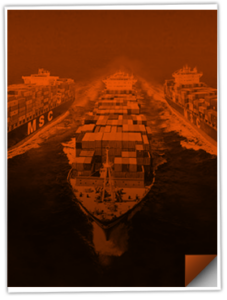Featured Headlines:
The November Comment Period to Remember
Air Passengers, the Cargo Challenger
The November Comment Period to Remember
- Per our previous ShapFlash, the Office of the U.S. Trade Representative (USTR) announced last month that they are seeking comments from the trade community regarding the overall utility and efficacy of Section 301 tariffs.
- Specifically, USTR officials are looking for information regarding the following:
- The effectiveness of the actions in eliminating the unreasonable and discriminatory actions, policies, and practices of the Government of China;
- The effectiveness of the actions in counteracting the Government of China’s actions policies, and practices;
- Alternative actions or modifications to existing actions to more effectively address these issues posed by the Government of China;
- Whether the actions resulted in higher additional duties on inputs used for additional manufacturing in the US rather than on downstream products or finished goods incorporating those inputs; and more!
- As a reminder, comments can be submitted via the USTR Comment Portal from November 15, 2022 until January 17, 2023.
- Click here to view the official Federal Register Notice; and click here to view the USTR Docket.
- If you have any questions related to Section 301 tariffs, please contact [email protected].
Rail Fail?
- OMG FWIW, the NRLC has announced that the BMWE has extended the cooling off period JIT, but the two sides better strike a deal (pun intended) PDQ!
- Glossary: OMG = Oh My God; FWIW = For What It’s Worth; NRLC = National Railway Labor Conference; BMWE = Brotherhood of Maintenance of Way Employees; JIT = Just in Time; PDQ = Pretty Damned Quick…. YW (you’re welcome)!
- With the original cooling-off period set to expire November 19th, the third largest rail labor union, the BMWE, has extended the period for negotiations to December 4th, making December 9th the earliest date for a strike action.
- As a reminder, seven of the twelve rail labor unions have confirmed final agreements; three labor groups have achieved tentative agreements that require ratification; two unions have already voted not to ratify; and one labor union went “wee wee wee all the way home.”
- The BMWE negotiation is seen as a crucial step to providing momentum for final negotiations with the three tentative deals; but, little has been said about the two deals that have essentially failed.
Trucking Trends
- Trucking capacity at the 20 largest US truckload carriers dropped slightly in Q3 2022, but remained close to the highest level in more than 10 years.
- The third quarter was the fourth consecutive time that the quarterly JOC Truckload Capacity Index remained above 90 (out of 100). The JOC index—which measures capacity based on actual truck counts at large publicly owned truckload carriers—dropped from 93.2 to 92.8 in Q3. This means the trucking industry in still in a good position to get an A- this semester…score!
- In other news, the JOC continues to post open positions for their “Counting Trucks Clerk” positions; these postings are now considered “perpetual!”
- Global merger and acquisition (M&A) activity is slowing after reaching new heights in 2021—but not in the US transportation and logistics market.
- As freight demand slows, more mid-sized brokers are seeing the benefit of owning some assets, while trucking firms are expanding their non-asset brokerages.
- Why can’t asset-based carriers and brokers just get along and stop all this finger-pointing, fighting, fake news, and falsehood mongering?! Wait, is this article about trucking or something that rhymes with “trucking” and happens to all of us, over and over again, in Washington DC?
- US trucking employment rebounded in October to a new record high after an abrupt and steep drop in September.
- In October, trucking gained 19,800 jobs—a 1.2% gain month-over-month, while recovering from a 17,800 job loss in September.
- Total transportation and warehousing employment rose 1% in October from September and was up 4.6% year-over-year (YoY).
- Warehousing and storage companies added 9,700 jobs, but this was far fewer than the almost 30,000 new hires expected.
Air Passengers, the Cargo Challenger
- Good news: revenue passenger kilometers (RPKs) are up at least 60% YoY this fall, landing (or taking off?) near 75% of pre-pandemic levels. More good news: a closer look shows domestic passenger traffic growing 7-10% per month steadily and international traffic more than doubling versus Fall 2021…woot! Bad news: more belly space for air cargo comes at just the wrong time for airline cargo operations already battling soft demand. More bad news: most of us STILL can’t easily convert kilometers to miles, and it is 2022! (Hint: a 5K race is just over three miles long. Hmmm, that didn’t really help, did it?)
- Fortunately for procrastinating air shippers, industrywide pricing has slipped almost 20% in six weeks due to a 5% capacity increase coupled with a 15% drop in chargeable kilos. German air exports are at their lowest ebb since the onset of the pandemic in 2020, and we are deeply sorry for using an ocean metaphor to describe airfreight realities.
- Interestingly, the Latin America air market continues to make its claim as “the little engine that could” after being the only market with YOY international air cargo growth (nearing 15%); good heavens, now we have attempted a railroad metaphor to describe air. Make it stop!
- Impressively, the airline industry has done a very solid job on load factors for both the passenger and cargo sides of the business. Passenger load efficiency is well above 80%, which bests 2019 levels. Despite so many commercial headwinds and such turbulence, air cargo operations have also modestly improved loading efficiencies. Good work!
The Global Grab Bag
- Rates for Indian exports—though eroding more slowing than Asia—are expected to average below $6000 per 40’ to the US in the coming weeks. Last week, rates from this crucial trade lane sank below July 2021 levels for the first time in 16 months.
- Market conditions for Asia-Europe are eerily similar to Asia-US trends. Historically, steamship lines could deploy larger vessels to the market enjoying stronger demand. With demand so poor for the world’s two largest trade lanes (by far), the carriers are stuck between a rock and rate avalanche.
- Colon, Panama is not just the go-to exotic destination for containers looking to sip cold drinks and work on that tan during a transshipment vacation! The port is also the focus of large investments by Evergreen Marine and MSC.
- Evergreen has earmarked $268 million to consolidate ownership of its Colon Container Terminal (CCT). Having witnessed nearly 100% growth since 2020, Evergreen considers the transshipment hub a vital necessity for their US East Coast and South America East Coast services. By buying out subsidiaries, Evergreen will grasp a direct role in the terminal’s management. The Taiwanese giant did mention that they would at least leave the yummy yucca cake and savory sancocho prep to locals.
- Not to be outdone, MSC has partnered with Notarc Management Group, a private equity fund, to resume construction of the Panama Canal Container Port (PCP). Based on the negative stigma of the acronym, many political and business leaders have begged MSC to call it PCCP at the very least!
The Trans Pathetic Trade Lane
- For the week ending November 5th (week 44 for you European and airfreight airheads), total transpacific eastbound container volume fell 26% YoY. That’s a drop we haven’t witnessed since Mel Gibson got tipsy, chose to drive, and then opened his mouth! (We know we have a Braveheart for saying that one…)
- Despite the decreasing, dipping, declining, diminishing, dwindling demand, the steamship lines keep fighting this perfect storm with blank sailings. Well over 150,000 TEUs a week, or 30% of today’s capacity, isn’t going from point A to point B (nor to anywhere at all). This trend is expected to continue and even increase into November. This is so extreme, dear readers, that we’ll let you fill in the blanks!
- Last Thursday’s walkout by longshoremen in Oakland was a stark reminder that the International Longshore and Warehouse Union (ILWU) and Pacific Maritime Association (PMA) are still far from a contract agreement, and that more regular and comprehensive work actions might take place along the west coast, as the stalemate drags on into its fifth month. Among farm animals, goats, sheep, and pigs could all have started new families in the time the west coast standoff has taken. Baa! Naa! Oink!
- Hey, ILWU, you better strike a deal before we get down to 10 containers a week into the west coast!!
- On the more positive side, thanks to weak demand, every single major US port is reporting fewer vessels at anchor over the last two weeks. The trend is positive, but it is interesting to note that there are still 87 vessels at anchor in total for US ports; in 2019, that number was generally in the single digits.
- Similarly, the average number of days delay to work vessels is down an impressive 40% for the west coast and a solid 20% for the east coast since January. The east coast continues to benefit from (and struggle with) traffic diversions from the west coast as shippers watch the ILWU/PMA wrestling match with a critical eye.
- It is important to note that current volumes remain over 7% higher than 2019 comparisons; and the main reason we all feel that Transpacific performance is pathetic is that we are comparing a “normal” second half of 2022 to 2021’s historic heights. And, as we have now said for 13 straight weeks, steamship industry capacity has been quietly growing for many, many months (and will continue to grow).
- Ocean carriers have “generously” extended current rates through the end of November, but none of us are fooled! The overall market dynamics indicate that we should see another $400 in reductions to the east coast; the west coast has less room for improvement as many carriers have reached break-even rate levels. It is difficult to show discipline after being robbed blind for two years, but shippers do not want carriers losing money for prolonged periods. No, no, no, vindictive readers! When the carriers are losing money, they offer meaningless contracts, and we’ve all lived through that delight!
- We watched with wonder as non-alliance carriers like Matson captured as much as 15% of the market by early 2022; these carriers also offered the most aggressive pricing during the surge. Now, it is the scaled monoliths in the industry (see poster children, MSC and Maersk) who are driving rates downward. It will be interesting to see how long the non-alliance players can hold onto that 15% market share!



